Bitcoin Magazine Pro
Are Retail Investors Behind The Bitcoin Price Surge This Bull Run?
Published
5 hours agoon
By
admin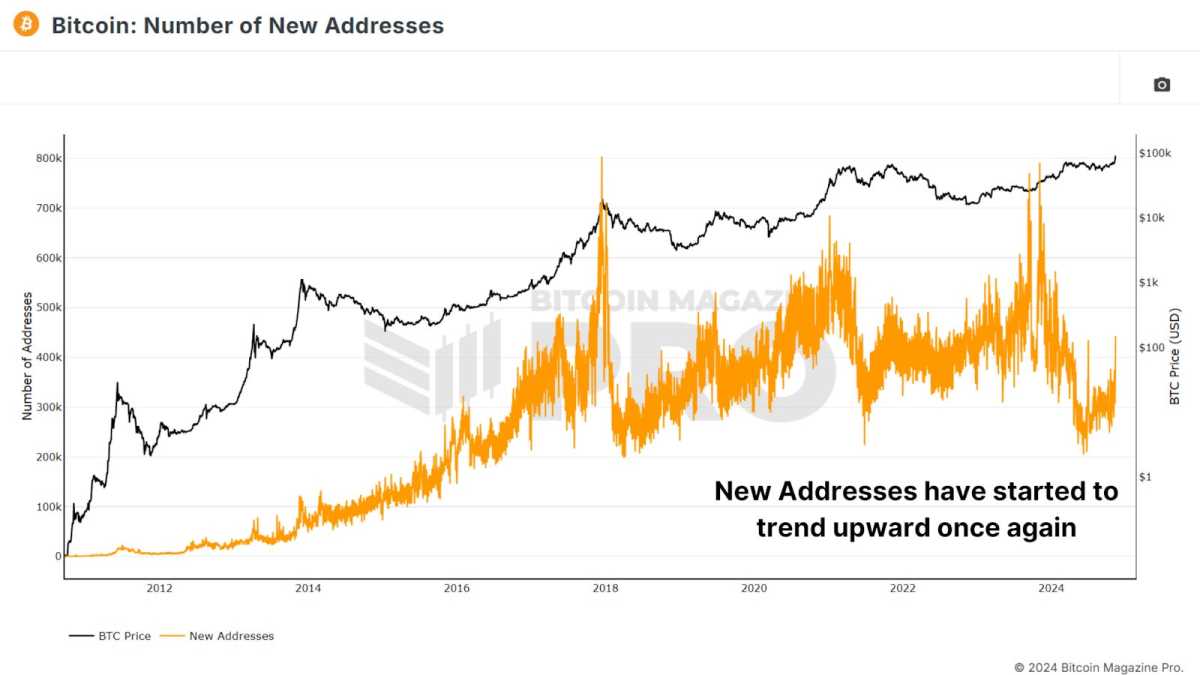
As Bitcoin once again finds itself in price discovery mode, market watchers and enthusiasts are curious: has retail FOMO set in yet, or is the retail surge we’ve seen in past bull cycles still on the horizon? Using data from active addresses, historical cycles, and various market indicators, we’ll examine where the Bitcoin market currently stands and what it might signal about the near future.
Rising Interest
One of the most direct signs of retail interest is the number of new Bitcoin addresses created. Historically, sharp increases in new addresses have often marked the beginning of a bull run as new retail investors flood into the market. In recent months, however, the growth in new addresses hasn’t been as sharp as one might expect. Last year, we saw around 791,000 new addresses created in a single day—a sign of considerable retail interest. In comparison, we now hover significantly lower, although we have recently seen a modest uptick in new addresses.

Google Trends also reflects this tempered interest. Although searches for “Bitcoin” have been increasing in the past month, they remain far below previous peaks in 2021 and 2017. It seems that retail investors are showing a renewed curiosity but not yet the fervent excitement typical of FOMO-driven markets.
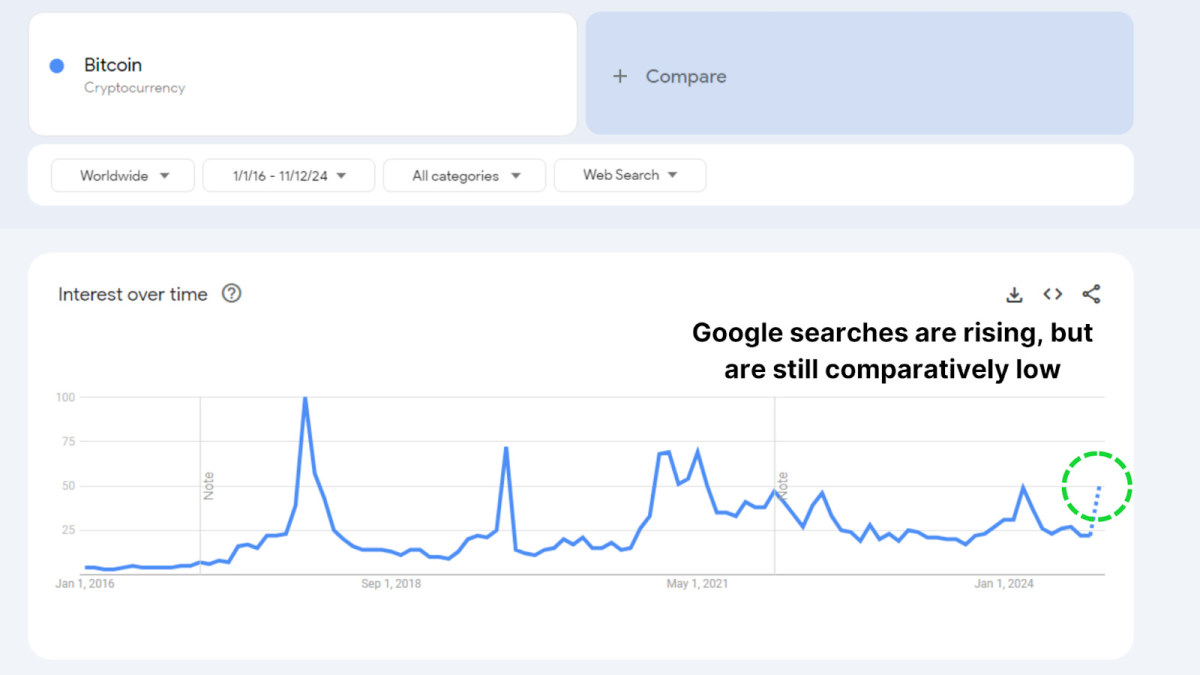
Supply Shift
We are witnessing a slight transition of Bitcoin from long-term holders to newer, shorter-term holders. This shift in supply can hint at the potential start of a new market phase, where experienced holders begin taking profits and selling to newer market participants. However, the overall number of coins transferred remains relatively low, indicating that long-term holders aren’t yet parting with their Bitcoin in significant volumes.
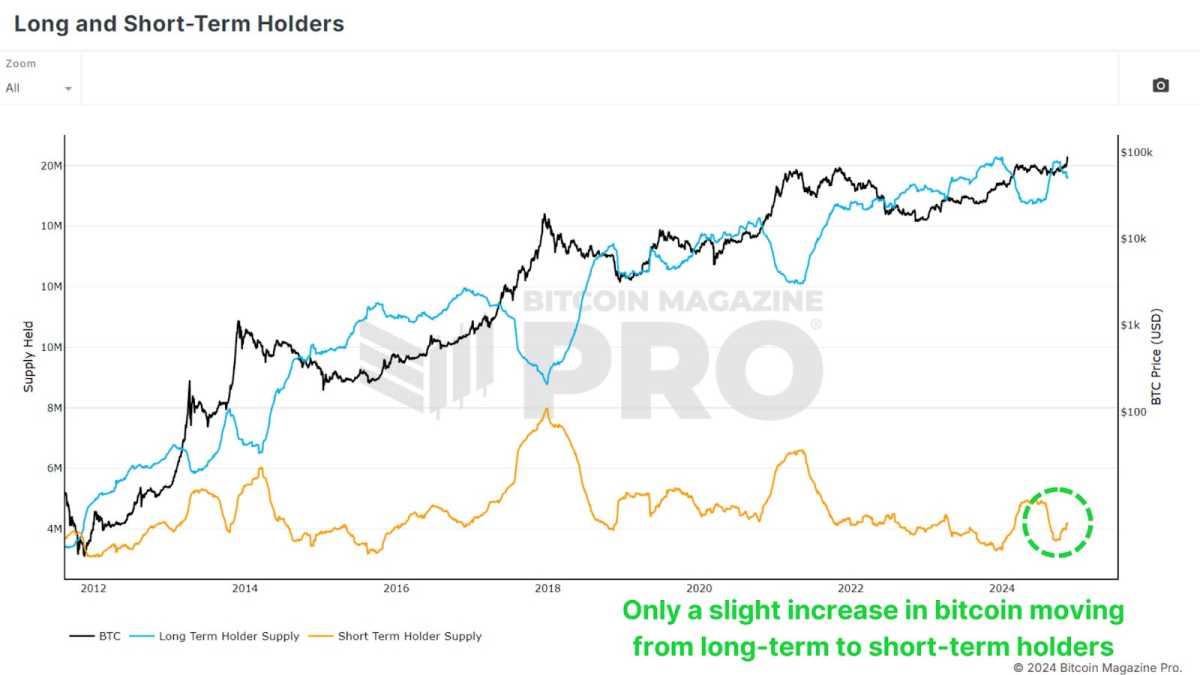
Historically, during the last bull run in 2020-2021, we saw large outflows from long-term holders to newer investors, which fueled a subsequent price rally. Currently, the shift is only minor, and long-term holders seem largely unfazed by current price levels, opting to hold onto their Bitcoin despite market gains. This reluctance to sell suggests that holders are confident in further upside potential.
A Spot-Driven Rally
A key aspect of Bitcoin’s latest rally is its spot-driven nature, in contrast to previous bull runs heavily fueled by leveraged positions. Open interest in Bitcoin derivatives has seen only minor increases, which stands in sharp contrast to prior peaks. For instance, open interest was significant before the FTX crash in 2022. A spot-driven market, without excessive leverage, tends to be more stable and resilient, as fewer investors are at risk of forced liquidation.
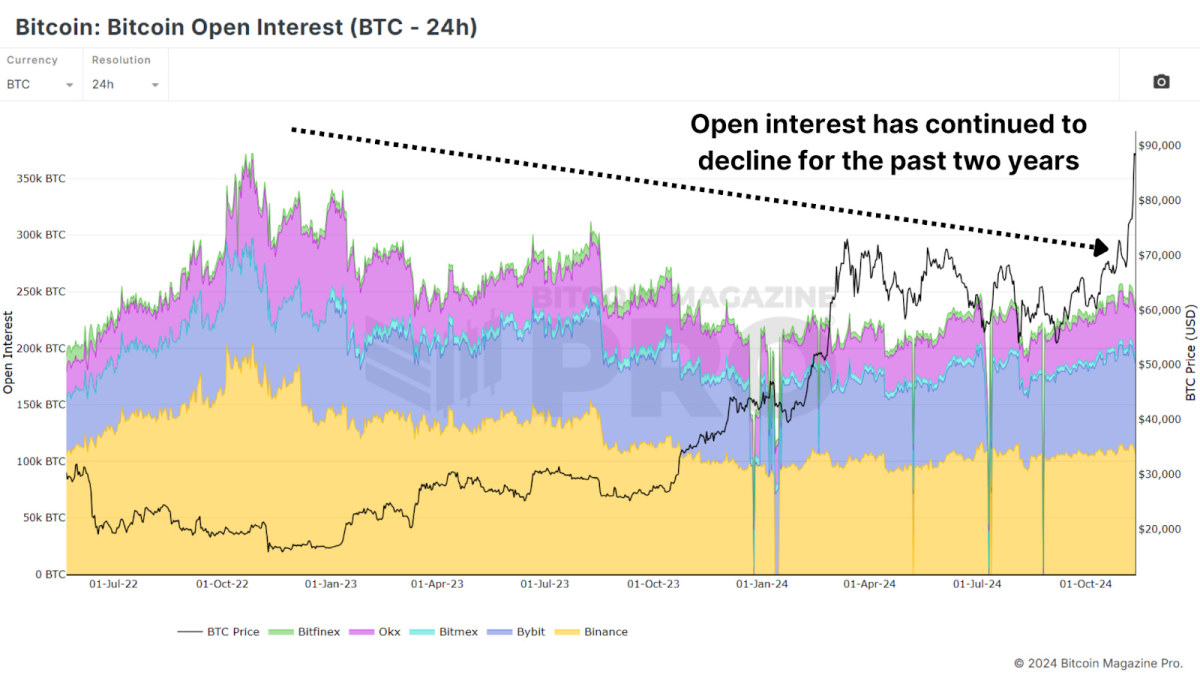
Big Holders Accumulating
Interestingly, while retail addresses haven’t increased substantially, “whale” addresses holding at least 100 BTC have been rising. Over the past few weeks, wallets with large BTC holdings have added tens of thousands of coins, amounting to billions of dollars in value. This increase signals confidence among Bitcoin’s largest investors that the current price levels have more room to grow, even as Bitcoin reaches all-time highs.
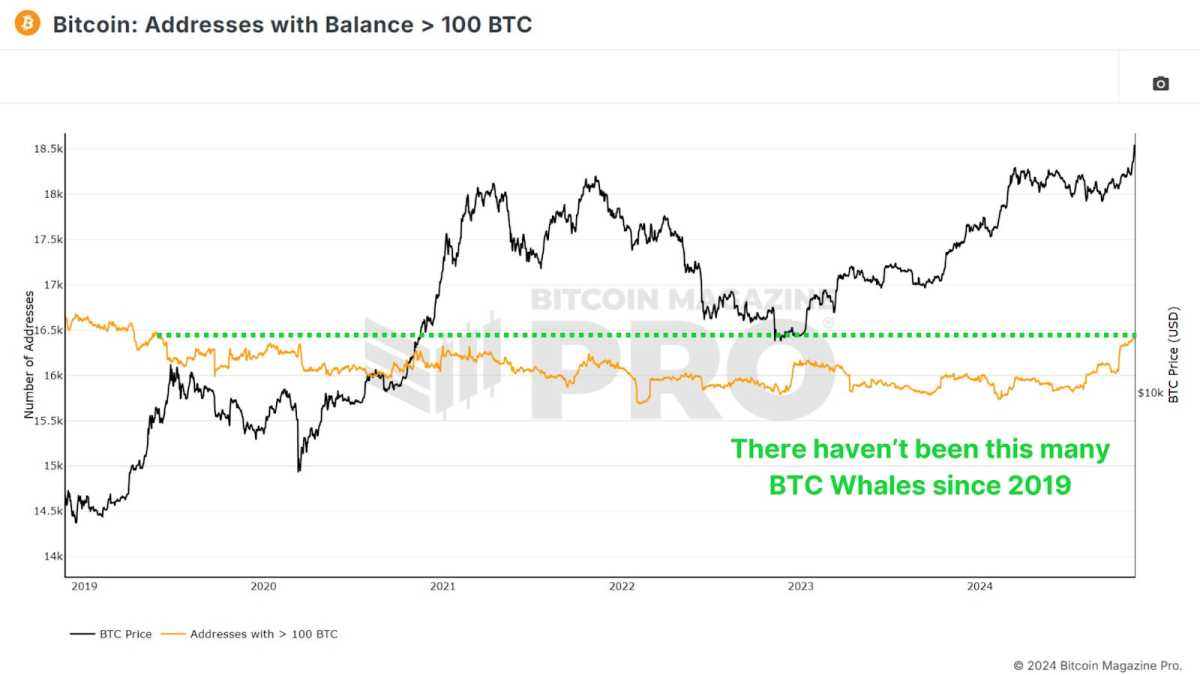
In past bull cycles, we saw whales exit or decrease their positions near market peaks, a behavior we’re not seeing this time. This trend of accumulation by experienced holders is a strong bullish indicator, as it suggests faith in the market’s long-term potential.
Conclusion
While Bitcoin’s rally to all-time highs has brought renewed attention, we’re not yet seeing the telltale signs of widespread retail FOMO. The subdued retail interest suggests we may be only in the beginning phase of this rally. Long-term holders remain confident, whales are accumulating, and leverage remains modest, all indicators of a healthy, sustainable rally.
As we continue into this bull cycle, the market’s structure suggests that the potential for a larger retail-driven surge remains ahead. If this retail interest materializes, it could propel Bitcoin to new heights.
For a more in-depth look into this topic, check out a recent YouTube video here: Has Retail Bitcoin FOMO Begun?
Source link
You may like


Bitcoin Price and the Psychological Leap: The Journey from $100K to $1M


Crypto Prices Cool as Fed Chair Jerome Powell Strikes Ambiguous Tone on Future Monetary Policy Choices


Solana investors rush to this new SOL-based meme coin as it eyes 5,000% price surge


Ripple CLO Criticizes Gary Gensler’s Justification For Crypto Lawsuits


How the US Military Says Its Billion Dollar AI Gamble Will Pay Off


Web3’s responsibility is to advance data privacy
Bitcoin Magazine Pro
The Truth About Bitcoin Price Models: Stock-to-Flow, Power Law, and Beyond
Published
3 days agoon
November 13, 2024By
admin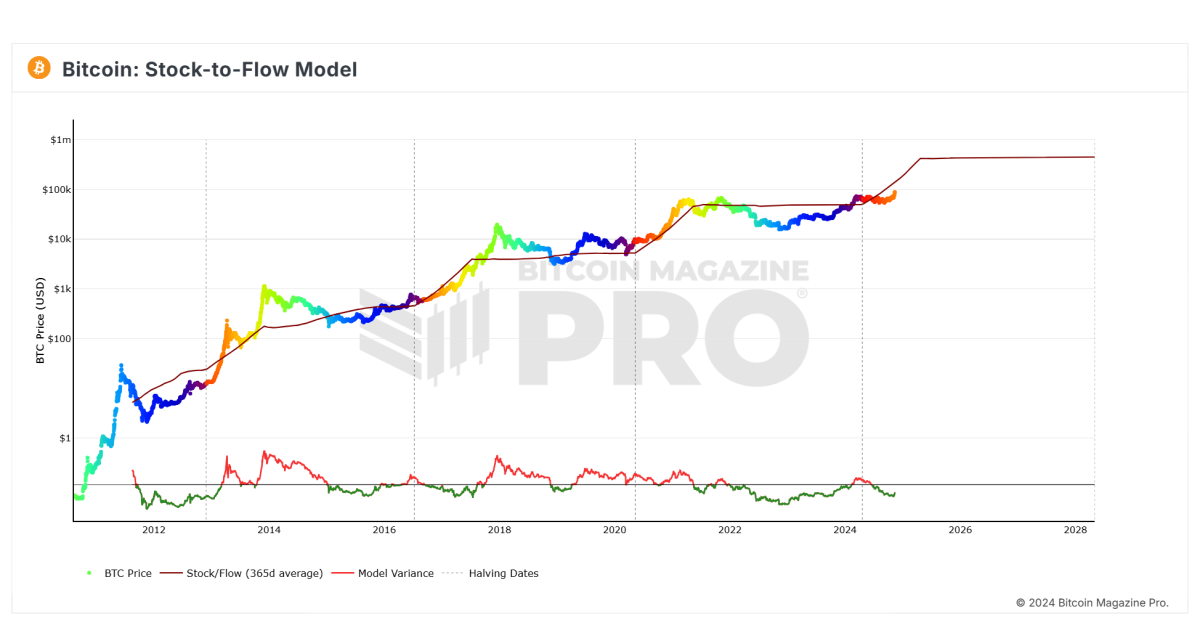
Predicting Bitcoin’s price has always been a hot topic for investors. Matt Crosby, lead market analyst at Bitcoin Magazine Pro, explores this topic in his recent video, “Truth About Bitcoin Stock To Flow, Power Law & Price Models“. Here, we break down Crosby’s key insights to help investors enhance their Bitcoin strategies.
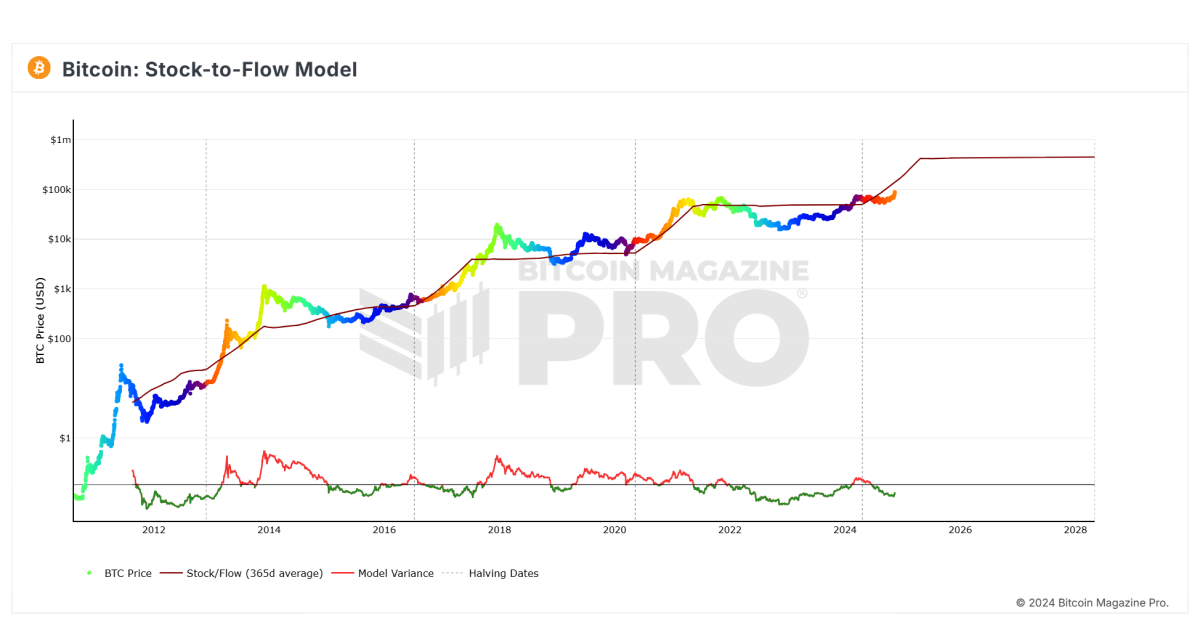
Stock-to-Flow (S2F): A Useful Tool, Not a Crystal Ball
The Stock-to-Flow (S2F) model is one of the most popular ways to predict Bitcoin prices, and Crosby explains its benefits and drawbacks clearly.
Key Takeaways:
- What Is S2F? S2F assesses Bitcoin’s scarcity by comparing the “stock” (current supply) to the “flow” (newly mined coins), similar to how rare commodities like gold are evaluated.
- Updated Predictions: The Cross-Asset S2F model initially forecasted Bitcoin hitting $288,000 between 2020 and 2024. More recently, it suggested a possible valuation of $420,000 by April 2025.
- Limitations: S2F works until unexpected events—like global economic changes—disrupt Bitcoin’s usual patterns. Crosby aptly points out, “S2F works until it doesn’t.”
While S2F is a helpful guide, it’s essential for investors to consider broader market conditions and macroeconomic influences alongside it.
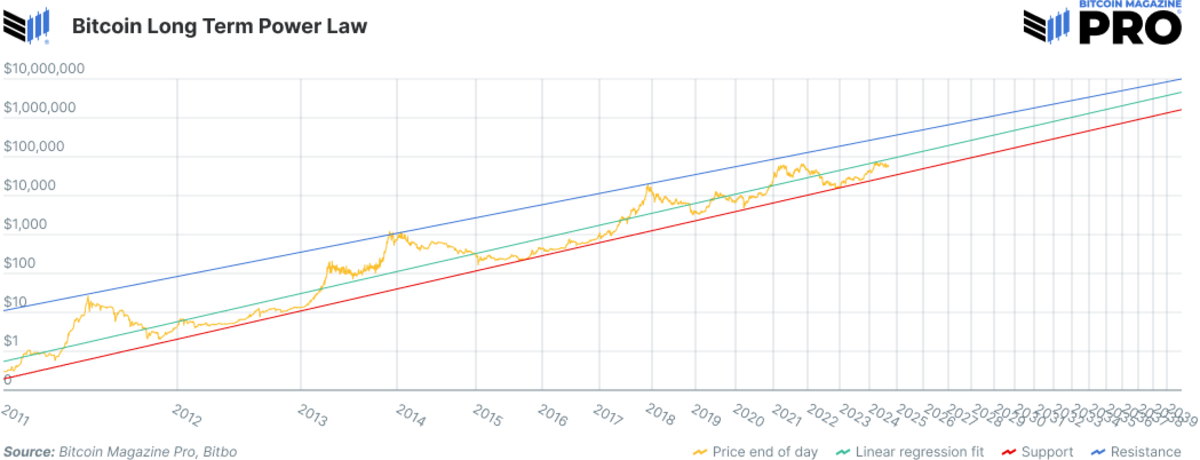
Bitcoin Power Law: The Long-Term View
Crosby also explores the Bitcoin Power Law, a model that uses a log-log chart to illustrate Bitcoin’s historical price patterns.
Why It Matters:
- Logarithmic Scaling: By using logarithmic scaling, the Power Law highlights Bitcoin’s long-term trend of reduced volatility and moderated growth.
- Limitations: This model offers insights for the long haul but is less helpful for short-term predictions or market surprises.
For investors aiming to diversify their portfolios and strategically time their investments, the Power Law provides context but should be used with other, more dynamic tools.
Real-Time Metrics: The Key to Adaptability
Crosby emphasizes the limits of static models like S2F and the Power Law, advocating for real-time, data-driven approaches instead.
Tools Investors Should Use:
- MVRV Z-Score: Measures market cap against realized cap, identifying when Bitcoin is overvalued or undervalued.
- SOPR (Spent Output Profit Ratio): Provides insights into market sentiment by tracking profit-taking behavior.
- On-Chain Metrics: Metrics like Bitcoin’s realized price and value-days-destroyed help detect market turning points.
These metrics give investors the tools to adapt their strategies to the market’s behavior in real-time rather than relying solely on predictions.
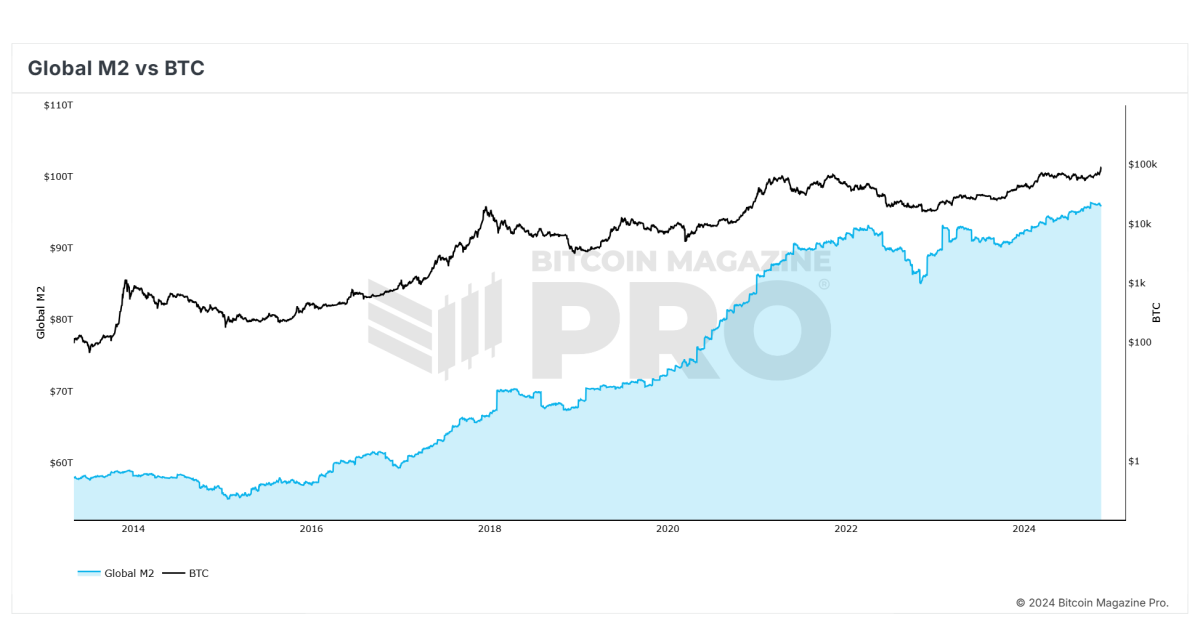
Why External Factors Matter
Crosby cautions against relying only on Bitcoin-specific data, emphasizing the importance of external factors:
- Global Liquidity: Bitcoin’s price often moves with global liquidity cycles, making macroeconomic awareness crucial.
- Institutional Adoption: Actions by major players such as sovereign wealth funds, corporate treasuries, or institutional asset managers can greatly influence Bitcoin’s price.
- Regulatory Changes: Government decisions to regulate or adopt Bitcoin can significantly affect its valuation.
Incorporating both macroeconomic factors and Bitcoin-specific metrics is key for a well-rounded analysis.
Final Thoughts: Stay Pragmatic
Crosby concludes by reminding investors that no single model can predict Bitcoin’s price with certainty. Instead, these tools should be used to provide structure and insight into an unpredictable asset.
Practical Tips for Investors:
- Use Multiple Models: Cross-check predictions using different models to gain a clearer understanding of the market.
- Embrace Real-Time Data: Rely on metrics like MVRV Z-score and SOPR for timely, actionable insights.
- Adapt to Change: Be ready to adjust strategies based on both internal data and external influences.
Bitcoin Magazine Pro offers advanced analytics and real-time data to help investors navigate this fast-paced market. To dive deeper into Crosby’s insights, watch the full video here: Truth About Bitcoin Stock To Flow, Power Law & Price Models.
Source link
Bitcoin Magazine Pro
Bitcoin Hash Ribbons Indicator: Miners Show Unwavering Optimism as Hash Rate Hits New Highs
Published
4 days agoon
November 12, 2024By
admin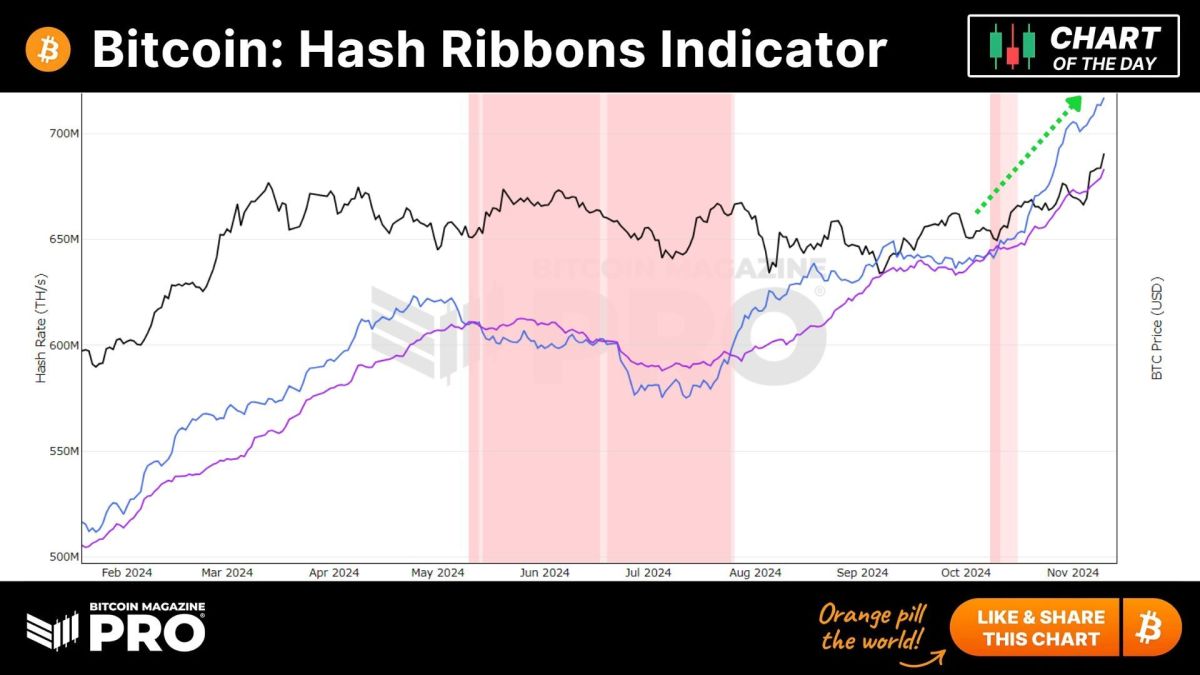
Bitcoin miners are sending a clear message: they’re more bullish than ever. As we observe new all-time highs in the Bitcoin network’s hash rate, the commitment of miners underscores their confidence in the asset’s long-term potential.

The Hash Ribbons Indicator Explained
The Hash Ribbons indicator provides insight into miner activity and sentiment by analyzing the 30-day and 60-day moving averages of Bitcoin’s hash rate. When the 30-day moving average crosses above the 60-day, it suggests a positive shift, often interpreted as miner capitulation coming to an end. This shift typically signals that weaker miners have exited the market, leaving only resilient participants and setting the stage for potential price recovery.
Why All-Time Highs in Hash Rate Matter
As the Bitcoin network’s hash rate climbs to new peaks, it highlights the increasing amount of computational power devoted to securing the blockchain. This rise not only reflects strong miner confidence but also enhances the network’s resilience and security. In the current climate, these hash rate highs indicate that miners are holding their ground, undeterred by market fluctuations.
Interpreting the Current Hash Ribbon Signal
The chart above shows a recent bullish crossover in the Hash Ribbons, indicating the end of miner capitulation. Historically, these crossovers have often aligned with favorable price action in the weeks and months that follow. With hash rate reaching unprecedented levels, this crossover suggests that miners anticipate a period of sustained growth.
For an in-depth look at the Hash Ribbons Indicator and to stay updated with future movements, visit the source here: Bitcoin Magazine Pro.
Source link
4 Year Cycle
Half Way Through The 4 Year Bitcoin Cycle
Published
1 week agoon
November 8, 2024By
admin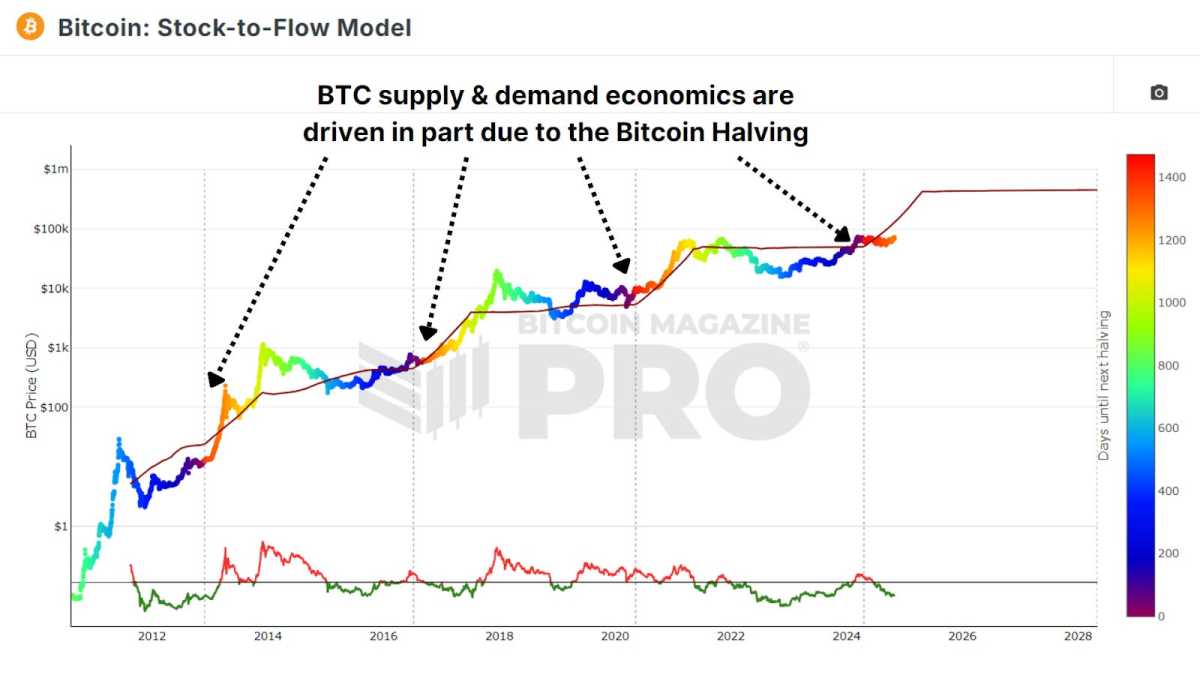
Bitcoin has historically followed a familiar four-year cycle. Now, two years into the current cycle, investors are closely watching patterns and market indicators for insights into what the next two years may hold. This article dives into the anatomy of Bitcoin’s four-year cycle, past market behavior, and future possibilities.
The 4 Year Cycle
Bitcoin’s four-year cycle is partly influenced by the scheduled halving events, which reduce the block reward miners receive by 50% every four years. This halving decreases the supply of new Bitcoin entering the market, often creating supply-demand pressures that can push prices higher.
This can be clearly visualized by the Stock-to-Flow Model, which compares the existing BTC in circulation to its inflationary rate, and models a ‘fair-value’ based on comparable hard assets such as Gold and Silver.

Currently, we’re midway through this cycle, meaning we are potentially entering a period of exponential gains as the typical one year catch-up phase following the halving progresses.
A Look Back at 2022
Two years ago, Bitcoin faced a severe crash amid a series of corporate implosions. November 2022 marked the downfall of FTX, as rumors of insolvency triggered massive sell-offs. The domino effect was brutal, as other crypto institutions, such as BlockFi, 3AC, Celsius, and Voyager Digital, also went under.

Bitcoin’s price tumbled from around $20,000 to $15,000, mirroring the broader market panic and leaving investors worried about Bitcoin’s survival. However, true to form, Bitcoin rallied again, climbing back up fivefold from the 2022 lows. Investors who weathered the storm were rewarded, and this rebound supports the argument that Bitcoin’s cyclical nature remains intact.
Similar Sentiment
In addition to price patterns, investor sentiment also follows a predictable rhythm across each cycle. Analyzing the Net Unrealized Profit and Loss (NUPL), a metric showing unrealized gains and losses in the market, suggests that emotions like euphoria, fear, and capitulation repeat regularly. Bitcoin investors typically face intense feelings of fear or pessimism during each bear market, only to shift back toward optimism and euphoria as prices recover and rise. Currently, we’re once again entering the ‘Belief’ stage following our early cycle runup and subsequent consolidation.
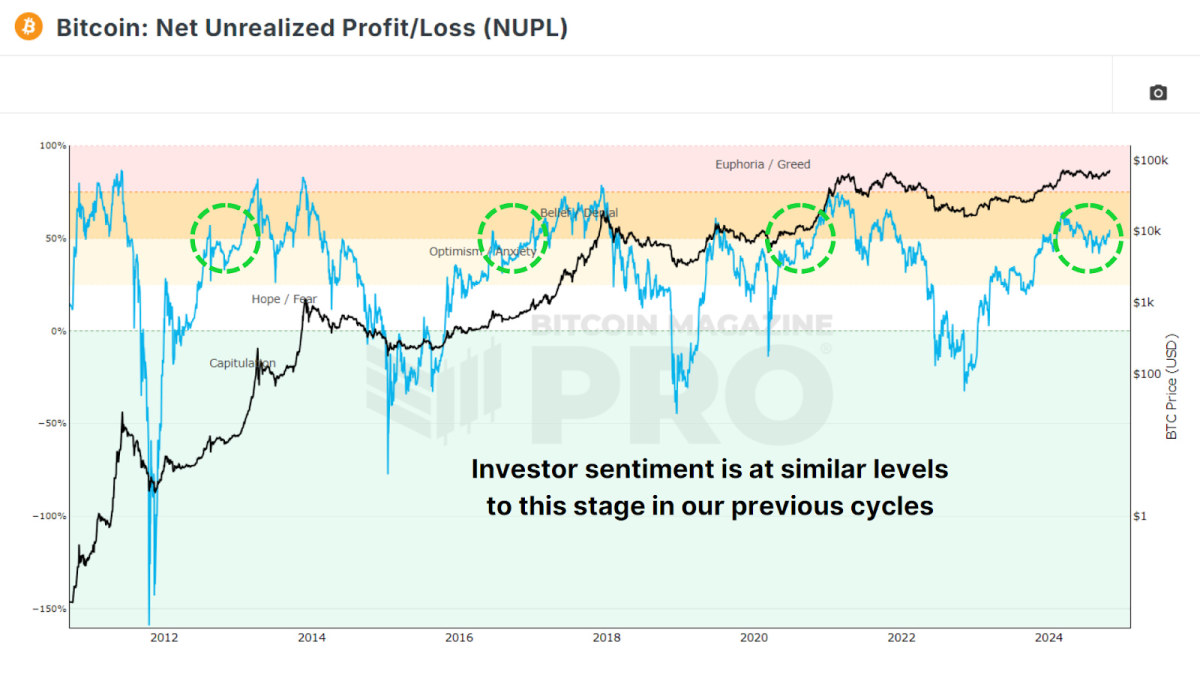
The Global Liquidity Cycle
The global money supply and cyclical liquidity, as measured by Global M2 YoY vs BTC, has also followed a four-year cycle. For instance, M2 liquidity bottomed out in 2015 and 2018, just as Bitcoin hit lows. In 2022, M2 again hit a low point, perfectly aligning with Bitcoin’s bear market bottom. Following these periods of economic contraction, we see fiscal expansion across central banks and governments everywhere, which leads to more favorable conditions for Bitcoin price appreciation.
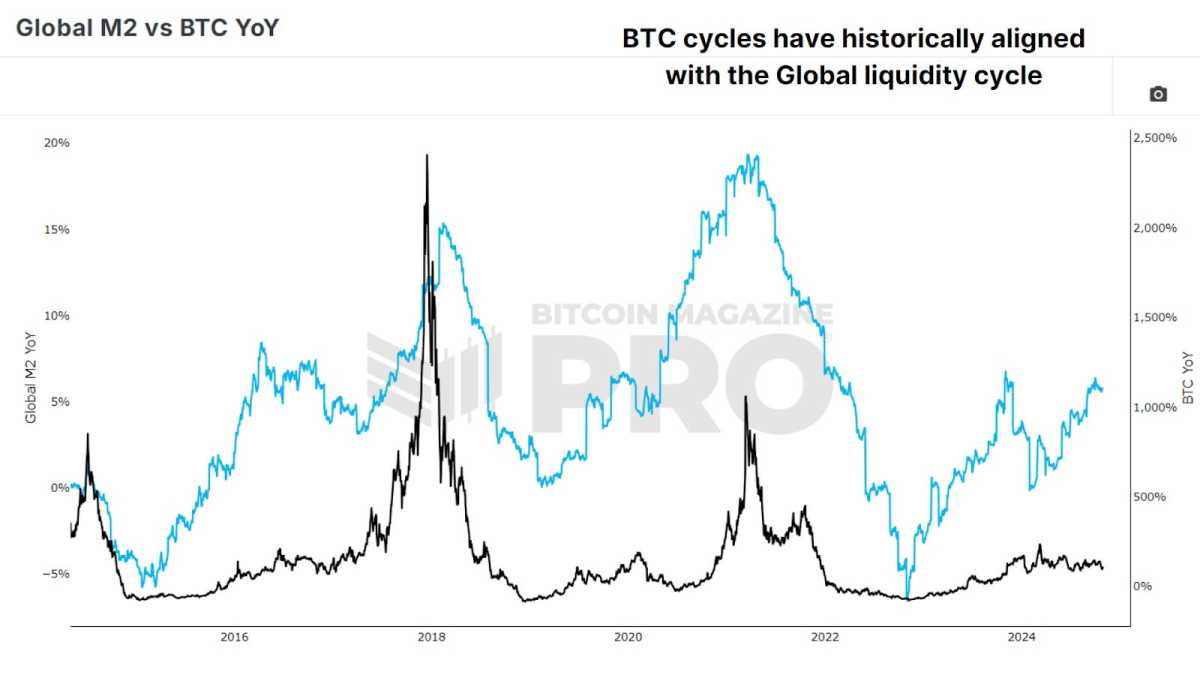
Familiar Patterns
Historical price analysis suggests that Bitcoin’s current trajectory is strikingly similar to previous cycles. From its lows, Bitcoin usually takes around 24-26 months to break past previous highs. In the last cycle, it took 26 months; in this cycle, Bitcoin’s price is on a similar upward trajectory after 24 months. Bitcoin has historically peaked about 35 months after its lows. If this pattern holds, we may see significant price increases through October 2025, after which another bear market could set in.
Following the anticipated peak, history suggests Bitcoin would enter a bear phase in 2026, lasting roughly one year until the next cycle begins anew. These patterns aren’t a guarantee but provide a roadmap that Bitcoin has adhered to in previous cycles. They offer a potential framework for investors to anticipate and adapt to the market.
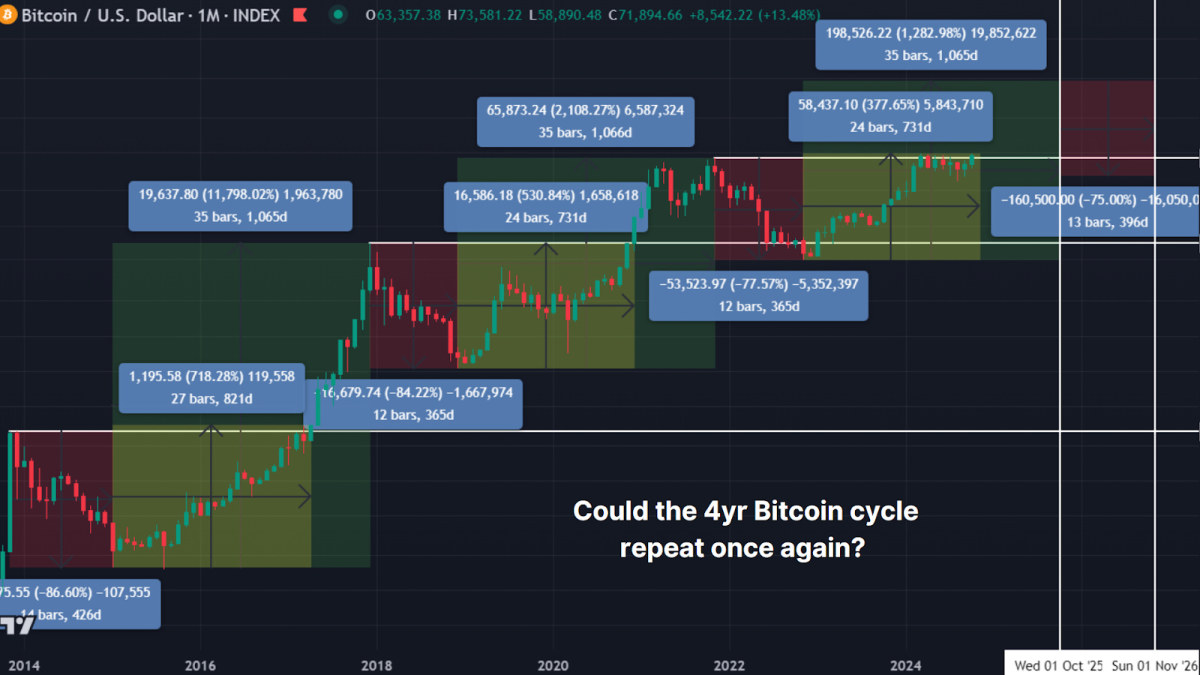
Conclusion
Despite challenges, Bitcoin’s four-year cycle has endured, largely due to its supply schedule, global liquidity, and investor psychology. As such, the four-year cycle remains a valuable tool for investors to interpret potential price movements in Bitcoin and our base case for the rest of this cycle. However, relying solely on this cycle could be shortsighted. By incorporating on-chain metrics, liquidity analysis, and real-time investor sentiment, data-driven approaches can help investors respond effectively to changing conditions.
For a more in-depth look into this topic, check out a recent YouTube video here: The 4 Year Bitcoin Cycle – Half Way Done?
Source link

Bitcoin Price and the Psychological Leap: The Journey from $100K to $1M

Crypto Prices Cool as Fed Chair Jerome Powell Strikes Ambiguous Tone on Future Monetary Policy Choices

Solana investors rush to this new SOL-based meme coin as it eyes 5,000% price surge

Ripple CLO Criticizes Gary Gensler’s Justification For Crypto Lawsuits

Are Retail Investors Behind The Bitcoin Price Surge This Bull Run?

How the US Military Says Its Billion Dollar AI Gamble Will Pay Off

Web3’s responsibility is to advance data privacy

Ripple Whales’ Massive Buying Indicates Breakout Ahead

NFL Legends Heading to MENA in Flag Football Showdown

What Does Trump's Win Mean for Crypto?

Meme hype takes over tokens, DOGE and XYZ are heading for ATHs

Dogecoin to Hit $4 As Elon Musk Says “D.O.G.E. Has Real Potential”

Buy As Much Bitcoin As You Can Before $100K
Bitcoin To $800K? Galaxy Digital CEO Unveils 5-10 Year Forecast

Floki whipsaws 14% on Coinbase listing
182267361726451435

Top Crypto News Headlines of The Week

Why Did Trump Change His Mind on Bitcoin?

New U.S. president must bring clarity to crypto regulation, analyst says

Ethereum, Solana touch key levels as Bitcoin spikes

Bitcoin Open-Source Development Takes The Stage In Nashville

Bitcoin 20% Surge In 3 Weeks Teases Record-Breaking Potential

Will XRP Price Defend $0.5 Support If SEC Decides to Appeal?

Ethereum Crash A Buying Opportunity? This Whale Thinks So

Shiba Inu Price Slips 4% as 3500% Burn Rate Surge Fails to Halt Correction

‘Hamster Kombat’ Airdrop Delayed as Pre-Market Trading for Telegram Game Expands

Washington financial watchdog warns of scam involving fake crypto ‘professors’

Citigroup Executive Steps Down To Explore Crypto
Mostbet Güvenilir Mi – Casino Bonus 2024

Bitcoin flashes indicator that often precedes higher prices: CryptoQuant
Trending

 2 months ago
2 months ago182267361726451435

 24/7 Cryptocurrency News3 months ago
24/7 Cryptocurrency News3 months agoTop Crypto News Headlines of The Week

 Donald Trump4 months ago
Donald Trump4 months agoWhy Did Trump Change His Mind on Bitcoin?

 News2 months ago
News2 months agoNew U.S. president must bring clarity to crypto regulation, analyst says

 Bitcoin4 months ago
Bitcoin4 months agoEthereum, Solana touch key levels as Bitcoin spikes

 Opinion4 months ago
Opinion4 months agoBitcoin Open-Source Development Takes The Stage In Nashville

 Bitcoin4 months ago
Bitcoin4 months agoBitcoin 20% Surge In 3 Weeks Teases Record-Breaking Potential

 Price analysis3 months ago
Price analysis3 months agoWill XRP Price Defend $0.5 Support If SEC Decides to Appeal?


